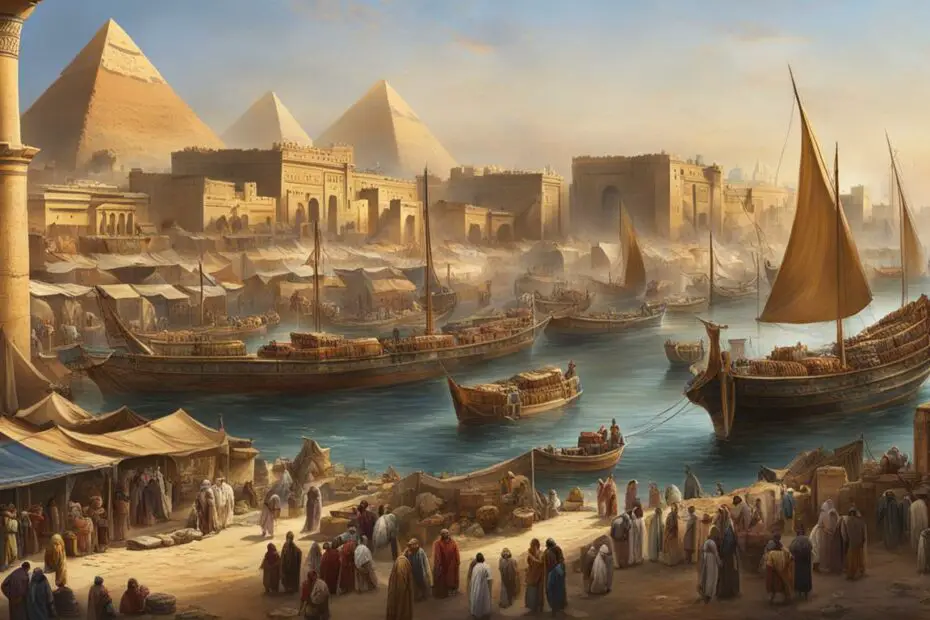Egypt’s strategic location in the Mediterranean region has positioned it as a crucial player in international trade. With a diverse economy and a transcontinental presence, the country boasts a vibrant maritime industry that supports various sectors of its economy. The Egyptian ports along the Mediterranean and Red Sea coasts serve as vital gateways for maritime trade, facilitating the movement of goods and connecting Egypt to global markets.
The Egyptian maritime industry plays a significant role in facilitating global commerce, attracting businesses both locally and internationally. With around 15 ports, Egypt has established itself as a key player in the region, offering state-of-the-art facilities and infrastructure to handle a diverse range of cargo.
From the historic Port of Alexandria to the thriving Port of Damietta, each port contributes uniquely to Egypt’s maritime landscape. These ports not only support trade but also create opportunities for growth and investment in the country’s economy.
In this article, we will explore the importance of Egypt’s ports, highlighting key ports such as the Port of Alexandria, Port of Damietta, Port Said, Suez Port, Port of Adabiya, Port of Safaga, Port Sokhna, Port Berenice, and shed light on the future developments and opportunities that await the Egyptian maritime industry.
Port of Alexandria: A Historical Trading Hub
The Port of Alexandria, dating back to 1900 BC, holds the distinction of being one of the world’s oldest operational ports. As a crucial gateway for maritime trade, it handles around three-fourths of Egypt’s trade, contributing significantly to the country’s trade revenue. Situated on Egypt’s northern coast, this historic port plays an integral role in the nation’s industrial, commercial, and agricultural sectors. It serves as a major hub for Egyptian shipping and facilitates vital trade routes, connecting Egypt to various international markets.
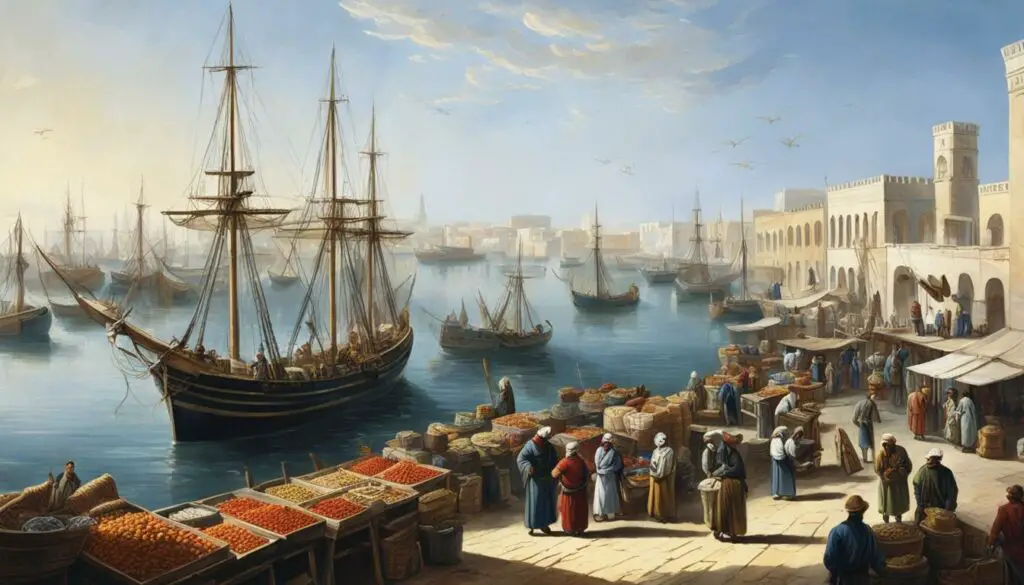
| Port Facts | Egyptian Shipping | Egyptian Trade Routes |
|---|---|---|
| Oldest operational port | Crucial role in maritime trade | Connects Egypt to international markets |
| Handles three-fourths of Egypt’s maritime trade | Contributes to Egypt’s trade revenue | Supports industrial, commercial, and agricultural sectors |
Port of Damietta: A Thriving Trade Center
The Port of Damietta, located close to the mouth of the Nile River, is the second busiest port in Egypt. It plays a vital role in facilitating maritime trade and serving as a crucial logistics hub for both domestic and international businesses.
The port handles a diverse range of goods, including agricultural products, fertilizers, furniture, cement, and general cargo. With its excellent facilities and infrastructure, it has established itself as a thriving trade center, attracting increased trade activities.
One of the key advantages of the Port of Damietta is its strategic location near the Nile River and Port Said. This allows for seamless connectivity and enhanced efficiency in the movement of goods, making it an ideal choice for businesses involved in Egyptian logistics.
Here is a glimpse of the types of goods handled at the Port of Damietta:
| Types of Goods | Description |
|---|---|
| Agricultural Products | Includes crops such as grains, fruits, and vegetables. |
| Fertilizers | Used to enhance soil fertility and support agricultural productivity. |
| Furniture | Includes a wide range of products, from home furniture to office equipment. |
| Cement | Essential for construction projects and infrastructure development. |
| General Cargo | Encompasses various types of non-specialized goods. |
The Port of Damietta’s ability to handle such diverse goods reflects its versatility and adaptability in meeting the demands of global trade. It offers efficient and reliable services, contributing to the overall growth and development of the Egyptian logistics sector.
With its strategic location, excellent facilities, and ongoing efforts to enhance infrastructure, the Port of Damietta is well-positioned to continue flourishing as a significant trade center in Egypt.
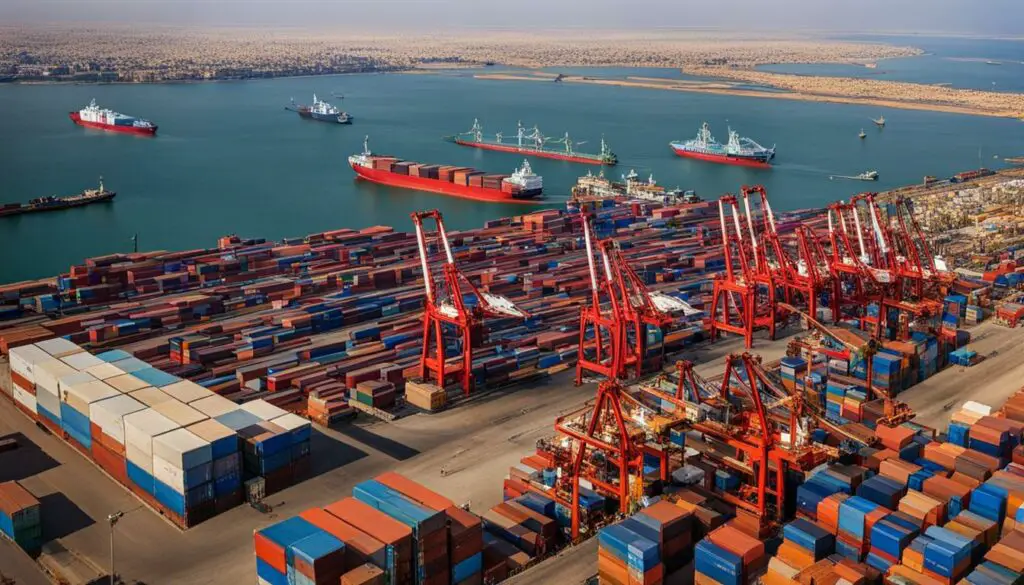
Port Said: A Key Entry Point to the Suez Canal
Port Said is a strategic port located at the northern entrance of the Suez Canal, making it a vital entry point to this iconic waterway. Its well-developed artificial harbor and state-of-the-art facilities enable it to efficiently handle a diverse range of cargo, including Egyptian cotton, rice, and various industrial products. Additionally, Port Said boasts a thriving fishing sector and supports a diverse industrial base, including textile manufacturing, glass making, and automobile production.
The strategic location of Port Said plays a crucial role in Egypt’s trade routes, connecting it to the global market. The port’s proximity to the Suez Canal offers significant advantages for international trade, allowing for efficient transit and seamless connectivity between the Mediterranean Sea and the Red Sea. Its excellent facilities and infrastructure make it a critical hub for the movement of goods and commodities, contributing to Egypt’s economic growth and prosperity.
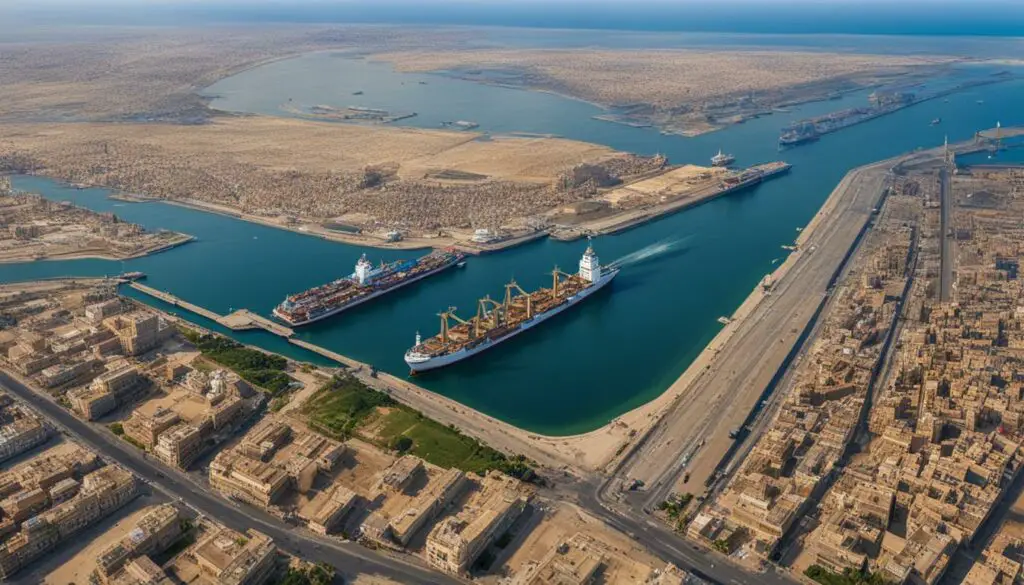
Port Said’s Economic Significance
The port of Port Said is not only an important gateway to the Suez Canal but also a major driver of economic development in the region. Its strategic location and excellent facilities attract a wide range of industries, contributing to job creation and economic growth. With its diverse industrial base, the port supports various sectors, such as agriculture, manufacturing, and trade, enhancing Egypt’s competitiveness on the global stage.
Port Said Key Statistics
| Cargo Handled | Port Facilities | Trade Routes |
|---|---|---|
| Egyptian cotton, rice, industrial products | Artificial harbor, advanced infrastructure | Connecting the Mediterranean Sea and the Red Sea |
| Fishing sector | State-of-the-art facilities | Global trade routes |
| Automobile production, textile manufacturing, glass making | Efficient cargo handling systems | International commerce |
Suez Port: Connecting the Mediterranean and Red Sea
The Port of Suez, located at the southern end of the Suez Canal, serves as a vital link connecting the Mediterranean and Red Sea. With its strategic location, the port plays a significant role in facilitating trade routes between these two important bodies of water.
The Port of Suez consists of two harbors, namely Port Ibrahim and Port Tawfiq. These harbors are well-connected to major cities like Cairo and Port Said through an extensive network of rail and road transportation. This efficient transportation infrastructure enables seamless movement of goods to and from the port, enhancing the efficiency of the supply chain.
The port handles a considerable volume of cargo, including containers, coal, and construction materials. This diverse range of goods reflects the importance of the port in supporting various industries and trade sectors. Furthermore, the Port of Suez also serves as a resting point for Muslim pilgrims traveling to Mecca and Medina, further consolidating its significance as a transit hub.
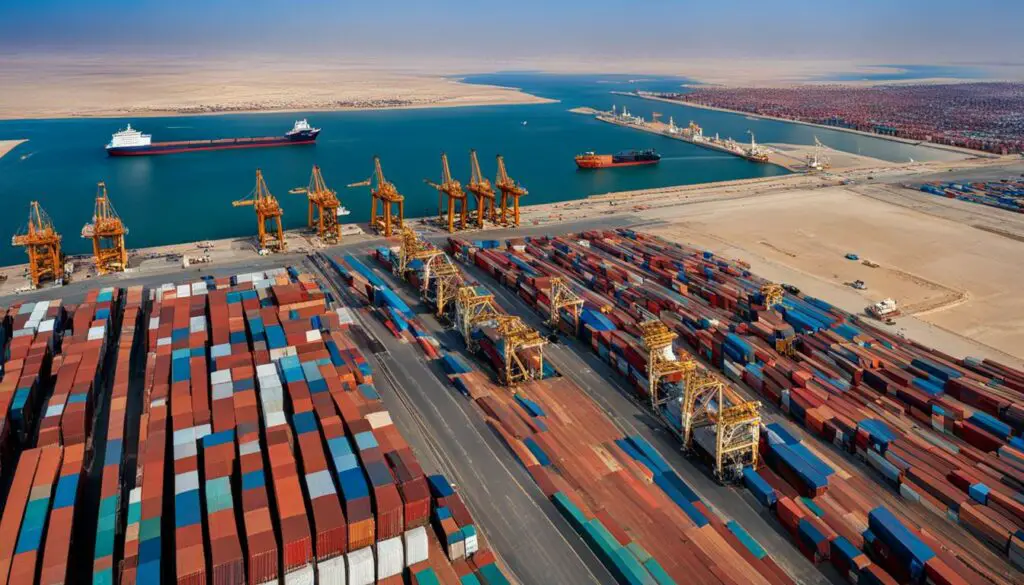
Port of Adabiya: A Strategic Location on the Suez Bay
The Port of Adabiya, located on the western coast of the Suez Bay, is one of the largest ports in Egypt. With its strategic location, it plays a crucial role in connecting Egypt to the Middle Eastern and East African markets. The port handles a wide range of goods, including grains, foodstuffs, cement, steel coils, and livestock, making it a vital hub for Egyptian logistics and trade routes.
Equipped with nine berthing facilities, the Port of Adabiya has undergone expansion to accommodate the growing cargo traffic. This expansion has increased the port’s productivity and efficiency, allowing it to efficiently handle the diverse range of goods passing through its facilities. The port’s continuous development enhances its capabilities and ensures it remains a key player in facilitating international trade for Egypt.
As a strategic access point to the Suez Bay, the Port of Adabiya offers extensive opportunities for businesses looking to connect with the Middle Eastern and East African markets. Its enhanced logistics infrastructure and excellent connectivity make it an attractive choice for companies seeking efficient and reliable trade routes in the region. With its strategic location and commitment to growth, the Port of Adabiya is poised to play an even more significant role in the Egyptian maritime industry.
| Port Facilities | Goods Handled | Main Trade Connections |
|---|---|---|
| 9 berths | Grains, foodstuffs, cement, steel coils, livestock | Middle Eastern and East African markets |
Port of Safaga: Gateway to the Red Sea
The Port of Safaga, located on the western coast of the Red Sea, serves as a vital gateway to the Red Sea region. With its strategic location and excellent facilities, it plays a crucial role in supporting trade and tourism in the area. The port handles a significant amount of passenger traffic and serves as a major hub for tourism.
Not only does the Port of Safaga facilitate tourism, but it also plays a key role in the import and export of various goods. The port handles a wide range of commodities, including minerals, petroleum products, and agricultural products. Its efficient logistics operations contribute to the seamless flow of trade in and out of Egypt.
With its well-connected transportation infrastructure, the Port of Safaga serves as an important link between Egypt and the Red Sea region. It provides access to crucial trade routes and supports the movement of goods to and from international markets.
By leveraging its strategic location and continuously improving its facilities, the Port of Safaga creates opportunities for businesses to expand their trade operations and capitalize on the thriving Red Sea market.
Port Sokhna: Connecting Egypt to International Markets
Located on the picturesque Red Sea coast, Port Sokhna plays a critical role in facilitating Egyptian trade and connecting the country to international markets. With its strategic location and excellent logistics infrastructure, the port serves as a vital gateway for the exchange of goods and commerce.
Port Sokhna handles a substantial volume of cargo, including containers and general goods, making it a key player in Egypt’s maritime industry. Equipped with state-of-the-art facilities, the port is capable of accommodating large container vessels, ensuring efficient and seamless operations.
One of the remarkable advantages of Port Sokhna is its proximity to significant trade routes, giving it direct access to global markets. This strategic location enables businesses to establish efficient supply chains, reducing transportation costs and enhancing trade efficiency.
Moreover, Port Sokhna’s advanced logistics infrastructure facilitates the smooth flow of goods, optimizing handling and warehousing capabilities. This ensures timely delivery and reduces bottlenecks in the supply chain, further bolstering trade activities.
Overall, Port Sokhna serves as a pivotal link between Egypt and international markets, fueling economic growth and fostering global trade collaborations. Its contributions to Egyptian logistics and trade routes make it a crucial player in the country’s maritime industry.
| Port Sokhna | |
|---|---|
| Location | Red Sea coast |
| Main Cargo Handled | Containers and general goods |
| Key Features |
|
| Role in Egyptian Trade | Connects Egypt to international markets |
Port Berenice: A Growing Hub in the Red Sea
The Port of Berenice, located on the Red Sea coast, is emerging as a prominent trade hub in the region. This strategic port handles a wide range of goods, including minerals, agricultural products, and general cargo, catering to the diverse needs of international trade. With its prime location close to major trade routes, the Port of Berenice is an attractive destination for businesses seeking to access the Red Sea market.
As part of ongoing development and expansion projects, the Port of Berenice is poised to become a significant player in the Red Sea area. With a focus on nurturing sustainable growth, the port authorities are investing in state-of-the-art facilities and implementing advanced logistical solutions to enhance operational efficiency and meet the evolving demands of the industry. These initiatives are not only contributing to the growth of Berenice as a trade hub but also bolstering the overall logistics capabilities of the Egyptian maritime industry.
Port of Berenice Key Facts and Figures
| Location | Red Sea coast, Egypt |
|---|---|
| Trade Routes | Connected to major international trade routes |
| Goods Handled | Minerals, agricultural products, general cargo |
| Facilities | State-of-the-art infrastructure and logistical solutions |
| Expansion Plans | Ongoing development and expansion projects |
| Importance | Emerging as a significant trade hub in the Red Sea area |
The growing prominence of the Port of Berenice presents lucrative opportunities for both domestic and international businesses. Its strategic location and efficient logistics infrastructure provide access to markets in the Red Sea region and beyond. As the port continues to expand and flourish, it anticipates attracting more trade and investment, further enhancing Egypt’s position as a key player in global trade routes.
With its vibrant trade ecosystem and commitment to continuous improvement, the Port of Berenice exemplifies the strength and potential of the Egyptian logistics industry. As businesses and industries tap into the opportunities offered by this growing trade hub, they contribute to the growth and development of the Egyptian economy as a whole.
Future Developments and Opportunities in Egyptian Ports
The Egyptian maritime industry is undergoing continuous development and expansion to meet the increasing demands of international trade. With its strategic location between Europe, Africa, and Asia, Egypt plays a crucial role in global commerce. As a result, there are numerous future opportunities for growth and advancement in the Egyptian ports sector.
One area of focus is the development of new ports along the Mediterranean and Red Sea coasts. These new ports will not only accommodate the growing traffic but also create additional gateways for maritime trade, enhancing Egypt’s connectivity to various international markets. The expansion of port facilities and infrastructure will ensure that the Egyptian logistics sector remains efficient and capable of handling diverse types of cargo.
Furthermore, the integration of advanced technologies in port operations is a key aspect of the industry’s future growth. Automation, artificial intelligence, and data analytics are revolutionizing the logistics sector, optimizing processes, and improving efficiency. Egyptian ports are embracing these technologies to streamline operations, reduce turnaround times, and enhance overall productivity.
The Egyptian government is actively promoting investment in the port sector, offering attractive incentives and opportunities for businesses to expand their operations. This favorable investment climate, coupled with ongoing infrastructure development initiatives, opens up new avenues for companies to contribute to the country’s economic growth while leveraging the advantages of the Egyptian maritime industry. As Egypt continues to strengthen its position as a key player in global trade, the future of the Egyptian ports sector looks promising.
FAQ
Q: What are some of the major ports in Egypt?
A: Some of the major ports in Egypt include the Port of Alexandria, Port Said, Suez Port, Port of Damietta, Port of Adabiya, Port of Safaga, Port Sokhna, and Port Berenice.
Q: What is the significance of the Port of Alexandria?
A: The Port of Alexandria is one of the oldest operational ports in the world and handles around three-fourths of Egypt’s maritime trade. It plays a vital role in Egypt’s industrial, commercial, and agricultural economy.
Q: Where is the Port of Damietta located?
A: The Port of Damietta is located close to the mouth of the Nile River. It serves as a thriving trade center and handles a diverse range of goods, including agricultural products, furniture, and cement.
Q: What is the role of Port Said in Egyptian trade?
A: Port Said is strategically located at the northern entrance of the Suez Canal and serves as a significant entry point to the canal. It handles various cargo, including Egyptian cotton, rice, and industrial products, and supports a large fishing sector.
Q: How does the Port of Suez contribute to Egyptian trade?
A: The Port of Suez is located at the southern end of the Suez Canal and serves as a vital link between the Mediterranean and Red Sea. It handles a significant volume of cargo, including containers and construction materials, and also serves as a resting point for Muslim pilgrims.
Q: What kind of goods does the Port of Adabiya handle?
A: The Port of Adabiya handles various goods, including grains, foodstuffs, cement, steel coils, and livestock. It plays a crucial role in connecting Egypt to the Middle Eastern and East African markets.
Q: Where is the Port of Safaga located?
A: The Port of Safaga is situated on the western coast of the Red Sea and serves as a gateway to the Red Sea region. It handles minerals, petroleum products, and agricultural products, and supports trade and tourism in the area.
Q: Why is Port Sokhna important for Egyptian trade?
A: Port Sokhna is located on the Red Sea coast and serves as an essential gateway for Egyptian trade. It handles a significant volume of cargo, including containers and general goods, and is equipped to handle large container vessels.
Q: What is the significance of the Port of Berenice?
A: The Port of Berenice is located on the Red Sea coast and is a growing hub for trade in the region. It handles a diverse range of goods, including minerals and agricultural products, and offers access to major trade routes.
Q: What are the future developments and opportunities in Egyptian ports?
A: Egyptian ports are undergoing development and expansion projects to meet growing demands. The integration of advanced technologies and the development of new ports are among the opportunities for growth in the Egyptian maritime industry.
